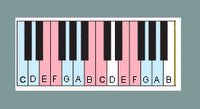Scales Tutorial
src="http://pagead2.googlesyndication.com/pagead/show_ads.js">
In this tutorial I am going to explain Major and Minor scales as easy as possible. This tutorial will be followed by a chords tutorial and a chord progression tutorial then possibly one on bass lines. If you have a lot of experience with music theory this tutorial is probably not for you, this is directed at beginners.
Tones and Semitones
 First off you need to know what tones and semitones are. Above is the picture of some piano keys with white keys labeled. Now as shown in the picture the blue keys are tones they always skip one key whether it be black or white. From C to D is a tone up, from G to A is also a tone.
First off you need to know what tones and semitones are. Above is the picture of some piano keys with white keys labeled. Now as shown in the picture the blue keys are tones they always skip one key whether it be black or white. From C to D is a tone up, from G to A is also a tone.
Now for semitones, they are shown in red above. They are keys that are right next to each other. From E to F is a semitone, from B to C is a semitone, and from D to D sharp or D to D flat is a semitone.
F.Y.I. If you don’t know what flats and sharps are look at D on the picture above. The black key above it is D sharp and the black key below it is D flat OR you could say the black key above D is E flat since it’s below E and the black key below is C sharp since it is above C. It depends on the circumstances.
Major Scales

Alright so now we know what tones and semitones are it’s time to discuss major scales. Now if you look at example one in the picture above I have labeled all the keys in the C major scale it goes from C to C. Now look at the tones and semitones you will notice it goes tone, tone, semitone, tone, tone, tone, and semitone.
Now you could for example think of this as a set of stairs. The tones are whole steps and the semitones are half steps. So it would go step, step, half step, step, step, step, and half step. Notice the half steps always happen between the third and fourth note and the seventh and eighth note. This applies to all the major scales; they all consist of this pattern. If you look at the picture above you’ll see that there’s 4 different major scales laid out and they all follow this pattern. It goes step, step, half step, step, step, step, and half step. Go ahead and sit at your keyboard and pick any key apply this pattern and you have the Major scale for that key.
F.Y.I. Remember to stay in key you will want to stay in the scale that you pick to use for your song. If you don’t your song will sound unpleasant you may though play in different octaves of the same key/scale.
Minor Scales
 Well now that you know major scales minor scales are easy. The half steps in the minor pattern happen between the 2nd and 3rd tones and 5th and 6th tones. So the pattern for minor scales is step, step, half step, step, step, half step, step, and step. Above is two examples as you can see you can apply this pattern to any key on the keyboard and you will have the Minor scale.
Well now that you know major scales minor scales are easy. The half steps in the minor pattern happen between the 2nd and 3rd tones and 5th and 6th tones. So the pattern for minor scales is step, step, half step, step, step, half step, step, and step. Above is two examples as you can see you can apply this pattern to any key on the keyboard and you will have the Minor scale.
Hopefully this tutorial was helpful and will give you a jump start in the right direction. If you want to learn more scales. Go to http://www.looknohands.com/chordhouse/piano/ . Now that you know that scales usually have a pattern of half steps you can look for and apply the patterns to your work. It should make it a lot easier to come up with scales on the fly without looking at a book or website. Until next time keep making music.
Filth



0 Comments:
Post a Comment
<< Home